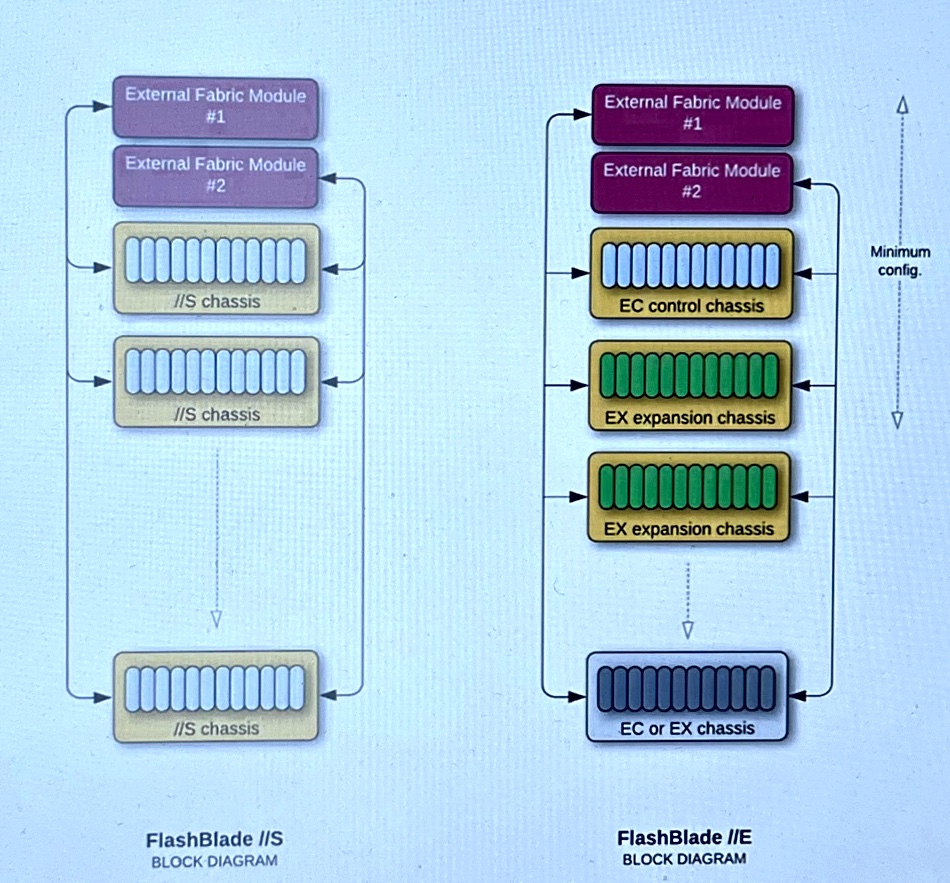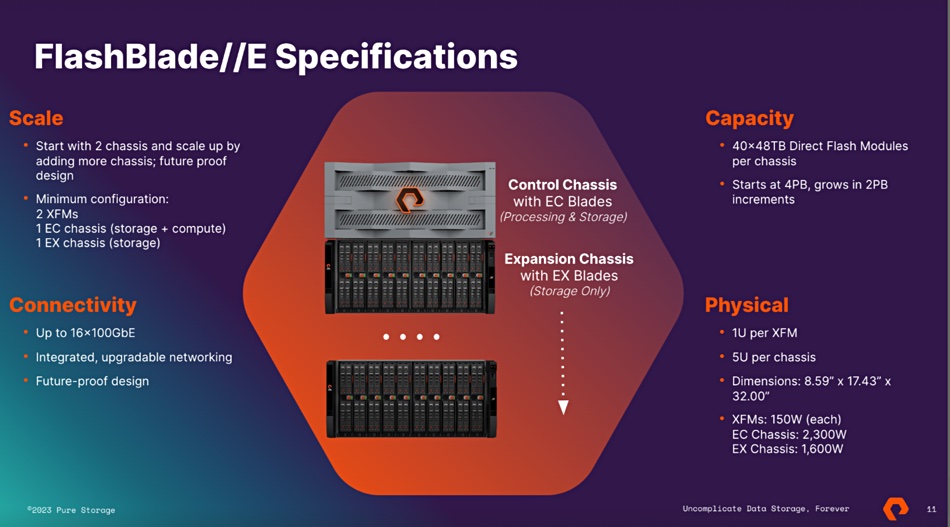Pure Storage says it has a new FlashBlade//E product optimized for capacity, designed to replace mainstream disk-based file and object stores with an acquisition price comparable to disk-based systems, and lower long-term cost of ownership, costing less than 20 cents per GB with three years’ support.

The FlashBlade//E has evolved from the existing FlashBlade//S and adds storage-only blades to the existing compute+storage blades, thus expanding capacity and lowering cost. Pure says it uses up to 5x less power than the disk arrays it is meant to replace and has 10-20x more reliability.
Amy Fowler, FlashBlade VP and GM, said: “With FlashBlade//E, we’re realizing our founders’ original vision of the all-flash datacenter. For workloads where flash was once price-prohibitive, we are thrilled to provide customers the major benefits Pure delivers at a TCO lower than disk.”
FlashBlade//E
FlashBlade//E starts with 4PB of capacity, using Pure’s 48TB Direct Flash Modules (DFM) and scales up in 2PB increments. For context, note that FlashBlade//S is for high-performance access to file+object data, with the S500 providing the fastest access and S200 providing slower access. Both can scale out to 10 chassis, meaning a max capacity of 19.2PB (10 chassis x 10 blade x 4 x 48TB DFM.)
The system starts with a head node, a 5RU EC control chassis with 10 compute+storage blades. Each holds a CPU with DDR4 DRAM DIMMs plus two or four 48TB QLC (4bits/cell) DFMs accessed via NVMe across a PCIe gen 4 bus. The Purity//FB OS runs the system. There will be two 1RU external fabric modules (XFM) to network blade chassis together.

There can be one or more EX expansion chassis, each with 10 storage blades, again fitted with two or four DFMs. There can be a maximum of 10 chassis in a cluster but this will contain more than 1 head node.

Customers tell a sizing tool how much capacity they need and it returns a configuration with an appropriate head-node/expansion storage chassis ratio. Pure’s Rajiev Rajavasireddy, VP Product Management, told B&F: “We give them a configuration that says, for this capacity, here’s the combination [of CPU and storage] that you’re going to need … We determine what that ratio is going to be for optimal performance as well as the capacity.”

He added: “What we’re effectively doing with E is we are actually increasing the amount of the storage each compute node actually manages, relative to the FlashBlade that somebody had … But there are limits beyond which it becomes counterproductive. The architecture is such that we can actually add more compute nodes as needed.”
FlashBlade//E DFMs cannot be used in //S systems.

Here’s the power draw picture;
- The Control Chassis with EC Blades consumes 2,300W
- The Expansion Chassis with EX Blades consumes 1,600W
- The two XFMs: 150W each
For a starting configuration of FlashBlade//E it’s about 1.06 W/TB, and for every expansion node with EX blades, 0.83 W/TB.
Performance
Rajavasireddy said: “Our performance is going to be just as good or even better than disk and disk hybrid system that we’re targeting. If you think about performance you have sequential throughput, you have random IO, you have large files, small files, and metadata.
“For sequential data, so for large files and sequential throughput, these disk-based systems are reasonably good because the heads are not seeking too much, they’re just running with the head in one position, for the most part. Our sequential throughput is going to be just as good or better.”
He said FlashBlade//E will do better than disk-based arrays with small files, random IO and metadata.
IO performance
IO access to these systems will be across faster versions of Ethernet, with 100 gigE today moving to 200 and then 400 gigE. PCie 4 can be expected to advance to PCIe 5. CTO Alex McMullan said: “We have no concerns on that side of things. We already have the engineering plan laid out in terms of network, in terms of PCIe links, to make sure that that is not a concern for us.”
These systems will have to be more reliable than today’s. McMullan said: “If you’re effectively collapsing five or 10 physical systems into one FlashBlade, it also has to drive up reliability in exactly the same way. And a big part of this for us has been about observability. It’s been about exporting a lot more metrics into things like [Pure analytics application] Prometheus for customers to be able to see, but also for us to monitor.”
Green flash and gunning for disk
The //E is more power-efficient than //S FlashBlade systems, drawing <1W/TB. McMullan told us: “We’re holding to the same power budget for drives as they get bigger and bigger, which nobody else can claim at this point in time … We’ll be getting below one watt per terabyte very quickly in the next few months. And our plan is to get into a discussion where it’s milliwatts per terabyte over the next two years.” In general, Pure says it’s delivering green flash at the price of disk.
It’s also better in e-waste terms as organizations tend to shred and send disk drives to landfill when they are replaced. DFMs don’t produce such e-waste as they can be recycled, Pure says.
Rajavasireddy told us: “With this FlashBlade//E we are targeting that volume of data that is currently running on disk and disk hybrid systems … We feel we finally have something that can go straight at the disk-based high capacity storage market.” A positioning diagram shows it in a 2D space defined by performance and capacity axes relative to FlashBlade//S:

Pure sums this up by claiming that, compared to HDD alternative systems, FlashBlade//E needs a fifth of the power, a fifth of the space, is 10-20x more reliable, has 60 percent lower operational cost and generates 85 percent less e-waste.
It is basically saying it’s going to invade the hybrid disk array market for mainstream bulk unstructured data that requires reasonably fast access and high capacity for workloads like data lakes, image repository, and video surveillance records – everyday file and object workloads. And it’s going to be doing it with drives that are larger than disk, require less energy than disk, and are more reliable than disk. And that when you throw them away, you don’t need a landfill site to hold the disk drive shreds.
Pure really does believe it can blow disk drive unstructured data arrays out of the water with FlashBlade//E. The system will be generally available by the end of April 2023 and can be supplied as a new service tier in Pure’s Evergreen//One Storage as-a-tier (STaaS) subscription.








